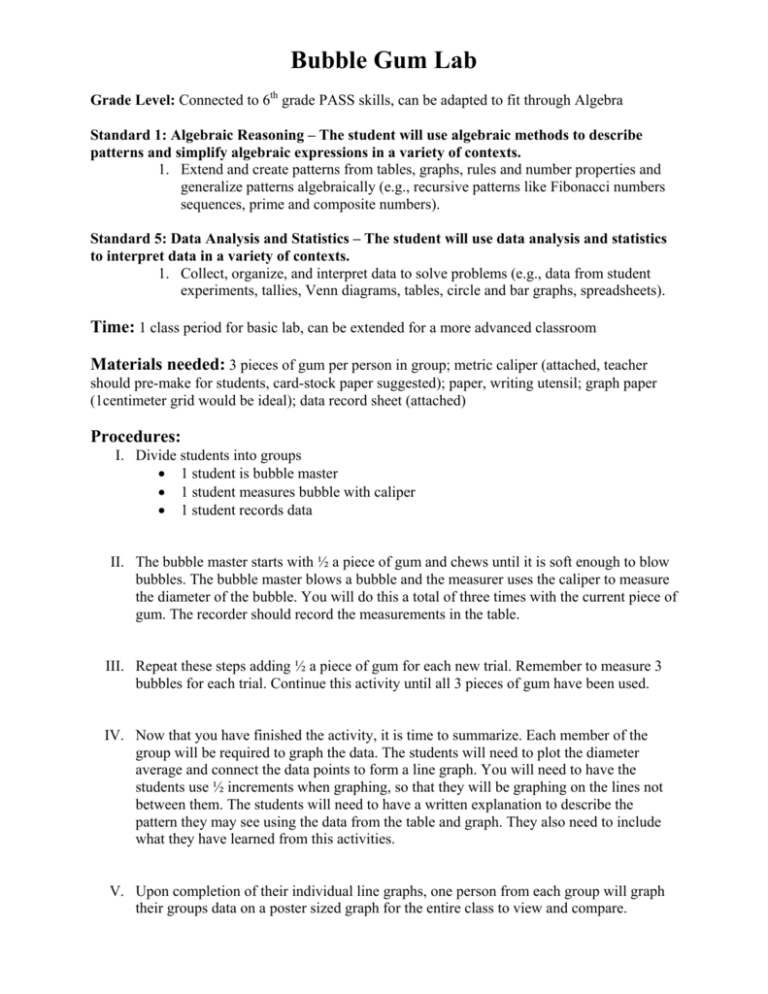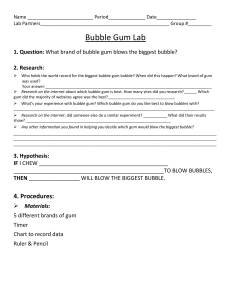Bubble Gum Lab: Algebra & Data Analysis Activity
advertisement

Bubble Gum Lab Grade Level: Connected to 6th grade PASS skills, can be adapted to fit through Algebra Standard 1: Algebraic Reasoning – The student will use algebraic methods to describe patterns and simplify algebraic expressions in a variety of contexts. 1. Extend and create patterns from tables, graphs, rules and number properties and generalize patterns algebraically (e.g., recursive patterns like Fibonacci numbers sequences, prime and composite numbers). Standard 5: Data Analysis and Statistics – The student will use data analysis and statistics to interpret data in a variety of contexts. 1. Collect, organize, and interpret data to solve problems (e.g., data from student experiments, tallies, Venn diagrams, tables, circle and bar graphs, spreadsheets). Time: 1 class period for basic lab, can be extended for a more advanced classroom Materials needed: 3 pieces of gum per person in group; metric caliper (attached, teacher should pre-make for students, card-stock paper suggested); paper, writing utensil; graph paper (1centimeter grid would be ideal); data record sheet (attached) Procedures: I. Divide students into groups • 1 student is bubble master • 1 student measures bubble with caliper • 1 student records data II. The bubble master starts with ½ a piece of gum and chews until it is soft enough to blow bubbles. The bubble master blows a bubble and the measurer uses the caliper to measure the diameter of the bubble. You will do this a total of three times with the current piece of gum. The recorder should record the measurements in the table. III. Repeat these steps adding ½ a piece of gum for each new trial. Remember to measure 3 bubbles for each trial. Continue this activity until all 3 pieces of gum have been used. IV. Now that you have finished the activity, it is time to summarize. Each member of the group will be required to graph the data. The students will need to plot the diameter average and connect the data points to form a line graph. You will need to have the students use ½ increments when graphing, so that they will be graphing on the lines not between them. The students will need to have a written explanation to describe the pattern they may see using the data from the table and graph. They also need to include what they have learned from this activities. V. Upon completion of their individual line graphs, one person from each group will graph their groups data on a poster sized graph for the entire class to view and compare. Discussion Questions: 1. 2. 3. 4. What relationship can you find from the graph? What is the ratio of the number of pieces of gum to the diameter? What type of graph do you get from the data? Can you predict the diameter of the bubble if you were using 4 whole pieces of gum? Bubble Gum Lab Data Record Sheet Trial 1. 2. 3. Diameter Average ½ 1 piece 1 ½ 2 2½ 3 piece of gum pieces pieces pieces pieces of gum of gum of gum of gum of gum Scoring Guide – Teacher Perspective Score Level Mathematical Knowledge & Understanding 4 (mastery of the problem) • • • • Collect data and complete table Graph data correctly Summary 1-2 paragraphs Answer all questions 3 (requires short note from teacher) • • • • • • • • • Complete table Graph correctly Summary 1 paragraph Answer some questions Collect data Incomplete table Graph attempted Minimal summary Questions not answered or answers incomplete Incomplete data Incomplete table No graph No summary Answered no questions 2 (requires teacher intervention) 1 (requires re-teaching) • • • • •







